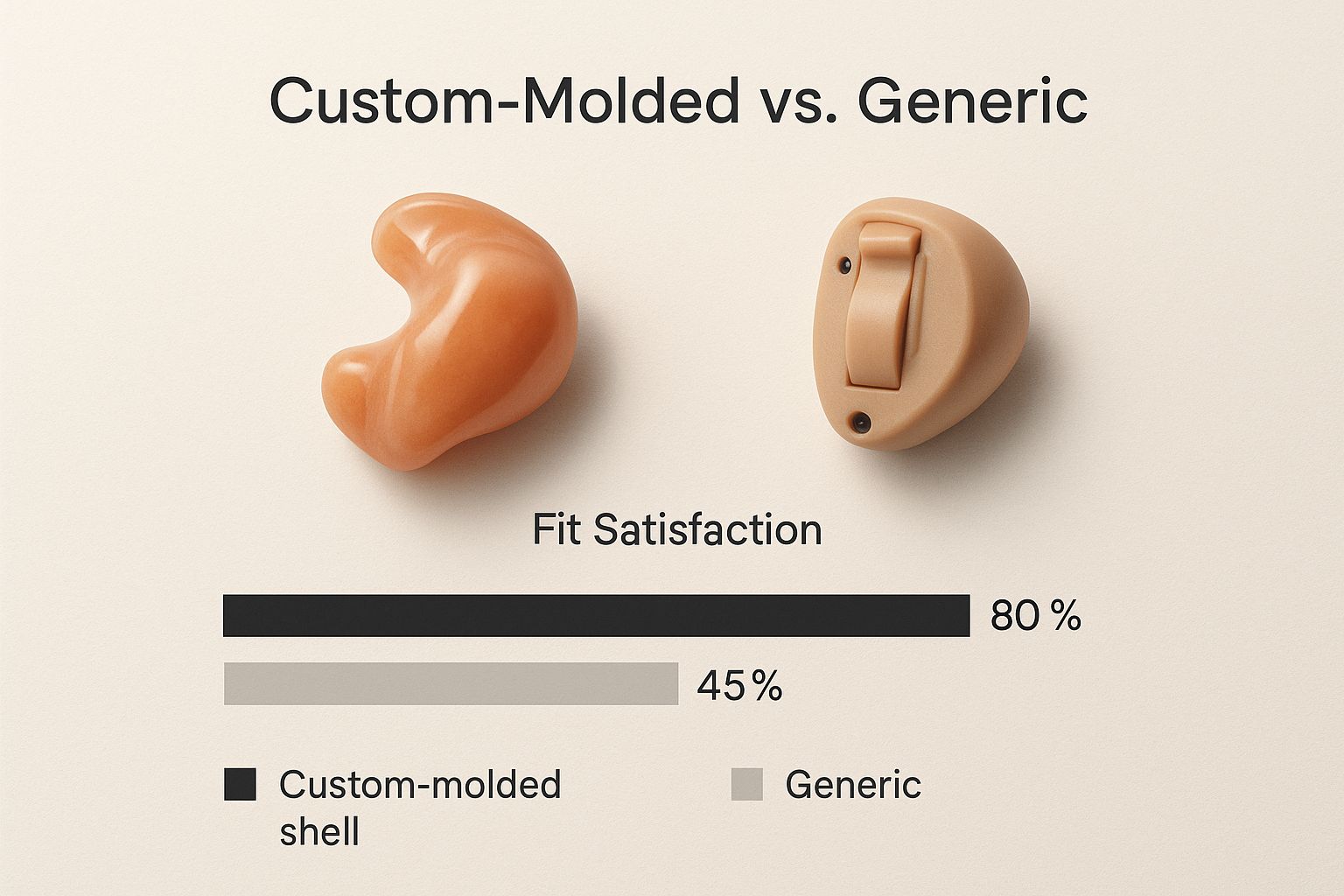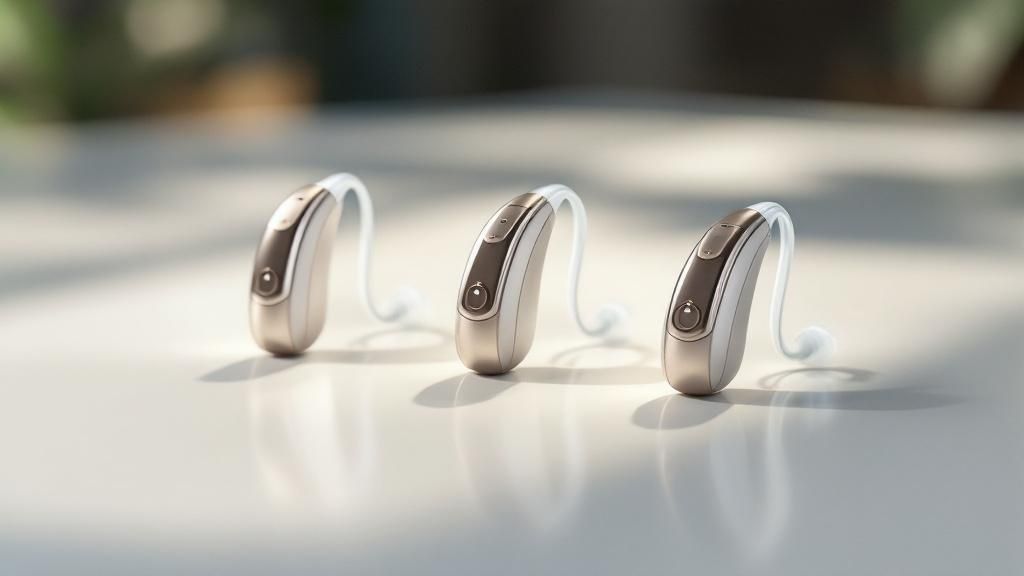Imagine leaning into a quiet conversation, catching every whispered word, the sound so natural you forget you're even wearing a hearing aid. For anyone with small ear canals, this probably sounds less like a reality and more like a distant dream, right?
The daily frustration is a story you know all too well—devices that pinch, that slip out at the worst moment, or that let out a high-pitched squeal just as you lean in for a hug.
But what if I told you that your ear anatomy isn't the problem? What if it's actually the key to unlocking a world of sound so clear and comfortable it feels like it was made just for you? This guide is your way out of that cycle of frustration. Forget the one-size-fits-all approach that has left you feeling sore and unheard. The path to a perfect fit begins now, and it’s a journey of precision, comfort, and discovery.
From Frustration to a Flawless, Invisible Fit
Let's be honest. The search for the right hearing aid can feel cold and clinical. It’s often a blur of confusing options, disappointing trials, and the sinking feeling that maybe, just maybe, you're the problem. Many people with narrower ear canals simply give up, convinced they are a "difficult fit."
But the truth is, a perfect fit isn’t about changing your ear; it’s about choosing a tool so perfectly engineered it becomes a part of you. The real challenge was never your anatomy—it was finding a device designed with your specific needs at its core.
This guide will pull back the curtain on the real issues and open your eyes to a world of custom-fit, nearly invisible hearing aids. By the end, you'll know exactly how to find a solution that delivers:
- Weightless Comfort: Imagine a device so perfectly shaped you forget it’s there.
- Crystal-Clear Sound: The whistling feedback and muffled audio will become a distant memory.
- Absolute Discretion: Discover options so small they are a secret only you know.
We're about to turn this search from a source of dread into an empowering journey. Your path toward sound that feels completely natural and effortless starts right now.
First, You Must Understand Why Your Ears Are Different
Ever tried to force a key into the wrong lock? No matter how much you jiggle it, it just won't turn. That's a perfect picture of what it feels like to use an off-the-shelf hearing aid when you have small ear canals.
You see, your ear canal isn't just a simple tube. It's a personal landscape, with its own unique curves, sharp bends, and hidden contours. For the roughly 15% of adults with smaller-than-average canals, this unique anatomy transforms a standard hearing aid from a potential solution into a constant source of pain.
The issue isn't a flaw in your ear. It’s a fundamental mismatch in design.
Then, You'll Realize the Problem Has a Name
When a hearing aid doesn't sit just right, it triggers a cascade of familiar frustrations. The device can't create a proper seal, undermining both your comfort and the quality of the sound you hear.
You might feel that constant, dull pressure, like something is always pushing against the sensitive skin inside your ear. Or maybe the device just won't stay put, slipping out with a simple turn of your head. But the most maddening problem of all is the one you can hear: acoustic feedback.
This is that high-pitched, piercing whistle that erupts when sound escapes your ear canal, gets caught by the hearing aid's microphone, and is instantly re-amplified into a screech. It’s the classic sign of a bad seal, and in the tight space of a small ear canal, it’s an all-too-common enemy.
And Finally, You'll See Why Standard Solutions Have Failed You
Beyond the whistle, a poor fit can trap sound in a way that creates the occlusion effect. This is that plugged-up, echoey sensation where your own voice booms inside your head, unnatural and loud. It happens when the hearing aid physically blocks the canal, trapping vibrations that would normally escape.
This blockage doesn't just distort your own voice; it muddies the very sounds you're trying to hear, making the world feel muffled or distant. Instead of clarity, you get a frustrating, plugged-up sensation. These issues reveal exactly why the one-size-fits-all approach has let you down.
Recognizing these challenges is the first step toward a solution. It's worth exploring the different kinds of hearing aid ear tips to understand how a proper seal is formed. Once you grasp this, your perspective will shift—you’re not a "difficult fit." You just need a solution built for your unique anatomy.
Now, Let's Uncover the Secret to a Perfect Fit
Knowing your ear’s unique shape is the first step. The giant leap forward is matching that shape with the right technology. When your ear canals are narrow, the style of hearing aid you choose isn't about preference—it’s the critical difference between all-day comfort and constant, nagging irritation.
This is where the engineering of specific models becomes so important. For a snug, secure fit, the best options are rarely the bulky devices that sit outside the ear. Instead, the solution lies deep inside the ear itself.
The goal is to find a device that feels like a natural extension of you, not an awkward accessory fighting the shape of your ear.
The Answer Lies in Devices Molded to Your Every Curve
For people with small ear canals, two styles consistently deliver what others cannot: Completely-In-Canal (CIC) and Invisible-In-Canal (IIC) hearing aids. These are not one-size-fits-all. They are custom-molded from a precise impression of your ear, ensuring they trace every unique curve and contour.
A CIC model sits almost entirely within your canal, with only a tiny removal handle visible. An IIC device goes even deeper, becoming truly invisible to the outside world. This deep placement uses your ear’s natural acoustics to its advantage, funneling sound directly to your eardrum for a clearer, more organic quality.
Because these devices are crafted specifically for your anatomy, the risk of a poor seal, that maddening feedback whistle, or the device slipping out is virtually eliminated. It’s the ultimate expression of personalized hearing technology.
But This Perfect Fit Comes with a Choice
While these in-canal models offer unparalleled discretion, they do come with certain trade-offs. Their tiny size means they use smaller batteries, which require more frequent changing than the larger batteries in Behind-The-Ear (BTE) models. They also may not have room for advanced features like dual microphones or robust Bluetooth connectivity.
Speaking of BTE devices, it's worth noting their place in the market. Statistics from 2023 show that BTE models held a dominant market share of over 40%, largely due to their powerful amplification and rich feature sets.
But the future is trending smaller. Canal hearing aids are projected to grow at a faster rate, driven by their invisibility and superior fit for people with smaller ear canals. The overall hearing aid market, estimated at $7.96 billion in 2023, is clearly shifting to meet this demand. You can explore more market trends about hearing aid technology on market.us.
The image below shows the stark difference between a generic device and a custom-molded one.

This visual highlights how a custom shell is sculpted to become one with the ear, while a generic device relies on a simple dome to create a less precise seal.
So, How Do You Choose Your Perfect Match?
Choosing a style is a strategic decision, balancing your desire for discretion with your lifestyle needs for connectivity and power. To make it clearer, let's break down how the most common styles stack up for smaller canals.
| Hearing Aid Style | Best for Small Canals? | Key Advantage for Small Canals | Potential Trade-Off |
|---|---|---|---|
| IIC (Invisible-In-Canal) | Excellent | Sits deepest for a truly custom, invisible fit. | Smallest batteries; may lack wireless features. |
| CIC (Completely-In-Canal) | Excellent | Custom-molded for a secure, comfortable fit. | Limited space for features like dual microphones. |
| ITC (In-The-Canal) | Good | Still custom-molded, slightly larger for more features. | More visible than IIC/CIC; may be too large for very narrow canals. |
| RIC (Receiver-In-Canal) | Fair to Good | Uses a tiny receiver wire, offering more comfort than a full shell. | The body of the device sits behind the ear, which some users dislike. |
| BTE (Behind-The-Ear) | Often Poor | The earmold can be customized, but the device itself is bulky. | The earmold can feel invasive and cause pressure in a small canal. |
Ultimately, the best choice marries the physical reality of your ear with the hearing support you need day-to-day. For those with narrow canals, IIC and CIC models almost always provide the most secure and comfortable starting point.
Imagine a Device That Thinks for You
A perfect physical fit is just the beginning. The shell of the hearing aid solves the puzzle of your ear's shape, but the technology inside is what unlocks a world of rich, clear sound. This is where your experience transforms from simply acceptable to genuinely effortless.
Think of it like this: a custom-molded shell is the perfectly tailored suit, but the features inside are the high-performance fabric that breathes, stretches, and keeps you comfortable all day. Without the right internal tech, even the best-fitting device will feel incomplete.
To get a device that sounds as good as it feels, you need a specific set of features working in harmony.
Technology That Erases Frustration
The tight confines of a small ear canal create unique acoustic challenges. Sound has less room to move, which can easily lead to that frustrating whistle or a plugged-up, echoey feeling. This is why specialized sound processing isn't just a luxury—it's essential.
Here’s what your device absolutely must have:
- Advanced Feedback Cancellation: This is your first line of defense against the dreaded whistling. Sophisticated algorithms actively detect and neutralize feedback before you ever hear it—a critical feature when the microphone and receiver are so close together.
- Occlusion Reduction Processing: This technology specifically targets the "booming" sound of your own voice. It digitally adjusts the output to let low-frequency sounds escape, making your voice sound natural instead of trapped inside your head.
- Digital Ear Scans for Molding: While traditional putty impressions work, modern digital scans create a hyper-accurate 3D map of your ear canal. This level of precision results in a flawless seal that maximizes both comfort and sound delivery.
These features work in concert to create a seamless listening experience. For more ideas on achieving all-day wearability, check out our guide on hearing aid comfort tips.
And Smart Features That Simplify Your Life
Modern hearing aids are more than just amplifiers; they're intelligent companions designed to adapt to your world. Today's tech has made hearing aids for small ear canals incredibly powerful and surprisingly user-friendly.
Innovations in digital signal processing, Bluetooth capabilities, rechargeable batteries, and AI integration have significantly improved the performance and adaptability of mini ear canal hearing aids. These developments also help reduce the social stigma tied to larger devices, making smaller models more appealing. You can discover more insights about the mini ear canal hearing aid market at dataintelo.com.
This evolution means you should expect more from your device. Essential smart features now include things like automated noise reduction, which filters out background clatter, and wireless connectivity for streaming calls or music directly. These are the tools that ensure your hearing aid works for you, not the other way around. Consider this your essential checklist for your conversation with a hearing professional.
Finally, a Clear Path to Finding Your Perfect Hearing Aid
Finding the right hearing aid shouldn't be a journey you take alone. Think of it as a partnership with a hearing professional, one that transforms a confusing medical process into an empowering and predictable experience. The goal is simple: to find a device that feels like a natural part of you.

It all begins with a comprehensive audiological exam. This is far more than a simple hearing test; it’s a deep dive into your unique hearing profile. A professional will map out your ability to hear different frequencies and, just as importantly, how well you understand speech in noisy situations. This creates a precise blueprint of your needs.
This first meeting is your chance to tell your story. Don't hold back. Talk about your lifestyle, the specific places where you struggle to hear most, and even your aesthetic preferences. This conversation is absolutely crucial for matching you with the right technology.
The Moment Your Custom Fit Is Crafted
Once your hearing profile is clear, the focus shifts to your physical anatomy. For custom-molded hearing aids for small ear canals, an exact impression of your ear is non-negotiable. A specialist will carefully place a soft, silicone-like material into your ear canal.
As it sets over a few minutes, it hardens into a perfect replica of every tiny curve and bend. This impression becomes the literal blueprint for your hearing aid's shell, guaranteeing a snug, comfortable, and acoustically sealed fit. It’s this precision that eliminates the pressure points and annoying feedback that plague off-the-shelf devices.
The fitting process is more than just a measurement; it’s a conversation. It’s your chance to ensure every aspect of your hearing health is addressed, leading to a solution that works in the real world, not just in a quiet office.
The Final Step: When Your Brain Rediscovers Sound
Your journey doesn't end the moment you receive your new hearing aids. Now comes the vital adjustment period. Your brain needs time to reacquaint itself with sounds it may not have heard clearly for years. At first, even everyday noises like running water might seem surprisingly loud.
This is normal. Give yourself time to adapt. Start by wearing your devices for just a few hours a day, then gradually increase the duration. It’s also incredibly important to master the cleaning routine, especially for deep-canal aids, to prevent wax buildup and keep them performing their best.
Never hesitate to schedule a follow-up for minor tune-ups. For a deeper understanding of all the options out there, you can also read our guide on how to choose hearing aids. This collaborative process is what ensures your new device perfectly supports your life.
It's Time to Reclaim the Sounds You've Been Missing
Let's return to the reason you started this journey: to reclaim the sounds of your life, without settling for "good enough." This is about more than tiny pieces of technology. It’s about the simple, profound joy of hearing a loved one’s whisper, the subtle rustle of leaves on a quiet morning, or every single word of a conversation in a bustling café.
Imagine living those moments, free from the constant distraction of a device that pinches, whistles, or keeps slipping out. When you have small ear canals, finding the right solution isn't a compromise—it's a matter of precision engineering meeting your unique anatomy.
Your Journey to a Richer Soundscape Starts Now
You're no longer guessing. You are now armed with the knowledge to find a device that fits both your anatomy and your lifestyle, perfectly. This understanding is empowering. It transforms what might have seemed like an intimidating process into a clear, confident path toward better hearing.
The demand for discreet, comfortable solutions is only getting bigger. In-the-canal hearing aids are seeing huge growth, especially among younger adults and professionals who value their cosmetic appeal. This isn't just a hunch; the data shows that retail and online sales now make up over 70% of hearing aid revenues. It's a clear signal that people want devices that blend seamlessly into their lives. You can dive deeper into these trends by checking out the current hearing aid market insights on towardshealthcare.com.
Your path to a richer, more comfortable world of sound begins with a single, informed conversation. A hearing professional can take all this newfound knowledge and help turn it into a tangible, life-changing solution.
While our main focus here has been on getting the perfect fit, we know other auditory challenges like tinnitus can also shape your experience. If that's part of your story, you might find this charity's tinnitus guide helpful for more information.
Go on, take that next step. A world full of rich, detailed sound is waiting for you.
Have Questions? We Have Answers.
When you're dealing with small ear canals, navigating the world of hearing aids can feel a little tricky. You've probably got some specific questions, and getting straight answers is the first step toward feeling confident in your choice. Let's clear up some of the most common concerns.
Can I Just Use Over-the-Counter Hearing Aids?
While the convenience of over-the-counter (OTC) hearing aids is a huge plus, they usually aren't the best route for small or uniquely shaped ear canals. It all comes down to one crucial thing: fit.
Most OTC devices are designed with a "one-size-fits-most" approach, using standard-sized tips that just won't work for a narrow canal. This can lead to discomfort, the aids falling out, or a failure to create a proper acoustic seal. That poor seal is exactly what causes that annoying whistling feedback and delivers muddy, subpar sound. For the best experience, a device designed for a snug, custom-like fit is almost always the right call.
Are Invisible Hearing Aids Automatically the Best Choice for Small Canals?
Not always. While those super-discreet Invisible-In-Canal (IIC) models seem like the obvious answer, their suitability depends on more than just how narrow your ear canal is. The specific shape and length of the canal are just as important.
Some narrow canals might be too short or have a sharp bend that makes it impossible to get that deep, secure placement an IIC device needs to work properly.
It's also worth remembering that the tiniest hearing aids come with a few trade-offs. The small size of an IIC often means smaller batteries that need changing more often and less room for features like Bluetooth streaming.
In these situations, a slightly larger Completely-In-Canal (CIC) model might be a more practical choice. It's still incredibly discreet but can offer a better balance between a secure fit and the features you want.
How Do You Properly Clean a Hearing Aid That Sits Deep in a Small Canal?
This is absolutely essential. When a hearing aid is nestled deep inside a narrow space, earwax can quickly become a problem, leading to blockages that muffle sound. Your hearing professional will give you a small toolkit, usually with a brush and a little wax loop or pick.
Giving the device a quick wipe-down every day is a good habit for removing surface gunk. But the real hero of your cleaning routine is the wax guard. This is the tiny white filter at the very tip of the hearing aid that sits inside your ear.
This little piece is your main line of defense, stopping wax from getting inside and damaging the sensitive electronics. You'll want to change it every few weeks or whenever you notice the sound getting weak or muffled. A consistent cleaning routine is the single best thing you can do to keep your hearing aids working perfectly for years.
Ready to hear the difference a perfect fit can make? HearDirectClub offers nearly invisible, self-fitting hearing aids that deliver crystal-clear audio without the hassle of a clinic visit. Find out if they're right for you with our 100-day risk-free trial at https://heardirectclub.com.





Leave a comment
This site is protected by hCaptcha and the hCaptcha Privacy Policy and Terms of Service apply.